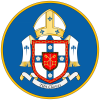A Triple Epiphany
Today is the Second Sunday after Epiphany. It is the day on which we commemorate the first miracle of our Lord, the changing of water into wine at the wedding feast of Cana. This miracle is counted as the third great Epiphany, or Manifestation, of Christ to the world, the day on which this world of ours is made aware that our Lord Jesus Christ is truly the Son of God and has power over and above the laws of nature. As the divine Creator of that nature, it follows that he is able to control and manipulate it whenever and however he wishes, and during the course of his ministry this power over nature will be displayed time and again as he performs his many miracles. Today is the first of those miracles, and thus forms a part of the great triple Epiphany that the world is given, the great announcement that here indeed is the long-awaited Messiah, the Son of God.
The Epiphany has three separate and distinct parts—all of which point to this single declaration to the world that Christ is God. When we think of Epiphany we immediately call to mind the adoration of the Magi, three kings who follow a star and bring their gifts of gold, frankincense and myrrh. They kneel before the Infant Jesus, acknowledging him before the world as the King of kings and Lord of lords. But there is more to come. Thirty years later, to herald in our Lord’s public ministry, a second Manifestation of Christ’s divinity takes place when our Lord is baptized in the River Jordan by his cousin St. John the Baptist. This was the second time the message is given to the world that he was the expected Messiah, a message this time conveyed by God himself, when a voice from heaven is heard by all present, announcing that “This is my beloved Son, in whom I am well pleased.” The third and final manifestation of our Lord, as we have already mentioned, is at the wedding feast of Cana, and today we celebrate this great event which brings to a close the Triple Epiphany.
We may wonder, with all the great miracles that our Lord performed during his ministry on earth, did he not begin with something more profound and spectacular than turning water into wine at a wedding reception. Having thus wondered, let us make our conclusions. There are two things which come to mind. The first is that it is a hidden miracle. Our Lord makes no command to the water, there is no “Ephphatha”, no “Abracadabra.” In fact, he doesn’t seem to actually do anything. His only words are to tell the servants to do whatever his Mother tells them. It is only afterwards that we realize a miracle has taken place as they taste the newly created wine and are amazed at its quality. Our Lord seeks no praise, no notoriety, he merely gives to his Mother the role of director in this first miracle. The second thing that comes to mind is that changing water into wine, one substance into another, is something he will repeat at the Last Supper when he gives to the Twelve Apostles the power of doing what only he can truly do, changing not water into wine this time, but wine into his own Blood, bread into his own Body. This first miracle of Jesus mirrors the great miracle of the Last Supper, a miracle that is performed daily by his Church at the Holy Sacrifice of the Mass.
When we see the Miracle of Cana in this light we should immediately see its significance in light of this continuous miracle of the Mass. For what is the Mass if not the continuation of the Sacrifice of our Lord on the Cross, what is it if not the perpetual memorial of our Redemption. “This is the chalice of my Blood, the Blood of the new and everlasting Covenant.” Today’s miracle of water-into-wine is the foreshadowing of the Mass, Cana is the foreshadowing of history’s greatest event, the Redemption of mankind, and history’s greatest marriage, that between Christ and his Bride, the Catholic Church.
Our annual commemoration of our Lord’s first miracle at Cana is mysteriously repeated at our Mass here this morning. During the silence of the consecration, our Lord changes one thing into another, and the wine of Cana becomes the Blood of the new and everlasting covenant between God and man. As at Cana we hear no words that proclaim this miracle. All that is said is the command, this time not to his Mother but to his apostles and their successors: “Do this in remembrance of me.” And in the footsteps of Holy Mary, we his priests do his bidding with the words of Christ at the Last Supper, “This is my Body, this is my Blood.” We hear nothing, see no changes, but the miracle has taken place, and it is only when we receive Holy Communion that the graces of the miracle become ours to taste and experience. Let us take this final lesson of Epiphany with us into the rest of the year. Let us try to be more aware of this, our own Epiphany, when Christ manifests himself to each of us individually and personally, every time we partake of his Most Blessed Sacrament.
